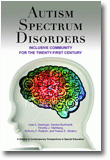
Autism Spectrum Disorders
Inclusive Community for the 21st Century
Edited by:
Julie A. Deisinger, Saint Xavier University
Sandra Burkhardt, Saint Xavier University
Timothy J. Wahlberg, Wahlberg and Associates
Anthony F. Rotatori, Saint Xavier University
Festus E. Obiakor, Sunny Educational Consulting
A volume in the series: Contemporary Perspectives in Special Education. Editor(s): Anthony F. Rotatori, Saint Xavier University. Festus E. Obiakor, Sunny Educational Consulting.
Published 2012
Autism Spectrum Disorders (ASD) has received considerable educational, research, medical and media attention the past ten years. Yet the condition was first described more than a hundred years ago. Due to the disorder being confused with childhood schizophrenia, there was a lack of definitive attention by special educators, medical professionals and mental health clinicians to advance parameters related to: causes; prevalence; identification and diagnosis; education and treatment. Positively, this confusion changed starting in the 1980s with the clarification of the differences between these disorders with the 1980 publication of the” Diagnostic and Statistical Manual of Mental Disorders” (DSM-III). Soon after, the 1990 federal legislation “Individuals with Disabilities Education Act” recognized the disorder as a disability category eligible for special education services. Both of these events lead to an explosion of information related to: finding causes; accurate identification and diagnosis; best educational practices; and social, emotional, and behavioral treatments.
Even with this explosion in the body of knowledge concerned with this disorder, much more needs to be learned and discovered. The successful use of this body of knowledge requires that accurate information be provided to educators, parents, clinicians, medical professionals, and mental health professionals to counter misinformation that exists among the general public, educators and clinical professionals. This is the primary purpose of “Autism Spectrum Disorders: Inclusive Community for the 21st Century”. It is accomplished by chapters on: the delineation of a blueprint for systems of care for persons with ASD and their families; a model to assist professionals in tackling the challenge of developing employability for individuals with high functioning ASD; best practice and research guidelines that lead to an affirmative ASD diagnosis; a comprehensive and current synopsis of genetic factors associated with ASD; adjustment challenges that may be present for a sibling of an individual with ASD; a comprehensive description of an innovative community-based clinic that provides services needed by Individuals with ASD to meet their social, behavioral, educational and mental health needs; and effective treatment strategies and techniques that can be utilized by parents and educators to work effectively with children who have ASD. The chapters are written by researchers, clinicians, business professionals, and university professors who have an extensive knowledge of ASD. The contents of the book are an excellent reference for special education teachers, school psychologists, practicing mental health clinicians, and parents and family members of children and adults with ASD.
CONTENTS
Preface. Systems of Care for Persons with Autism Spectrum Disorders and Their Families: From Puzzle to Blueprint, Sandra Burkhardt. ASD Workforce: Workplace Access for Persons With Autism Spectrum Disorders, Sandra Burkhardt and Sandra Cardillo. The Process of Obtaining an Autism Spectrum Diagnosis, Julie A. Deisinger. Genetic Factors Associated With Autism Spectrum Disorders, Julie A. Deisinger. Recent Findings About Siblings of People With Autism Spectrum Disorders, Julie A. Deisinger. An Innovative Community-Based Clinic That Serves Individuals With Autism Spectrum Disorders, Anthony F. Rotatori, Julie A. Deisinger, Timothy J. Wahlberg, Sandra Burkhardt and Festus E. Obiakor. Treatment and Techniques, Timothy J. Wahlberg. Strategies for Emotional Regulation, Timothy J. Wahlberg. Coping With Other Life Issues, Timothy J. Wahlberg. About the Contributors.
-
Paperback978-1-61735-780-0
Web price: $45.04 (Reg. 52.99)
-
Hardcover978-1-61735-781-7
Web price: $80.74 (Reg. 94.99)
- eBook978-1-61735-782-4

-
 Critical Issues in Preparing Effective Early Childhood Special Education Teachers for the 21 Century Classroom
Interdisciplinary Perspectives
Critical Issues in Preparing Effective Early Childhood Special Education Teachers for the 21 Century Classroom
Interdisciplinary Perspectives
-
 Educating Young Children With and Without Exceptionalities
New Perspectives
Educating Young Children With and Without Exceptionalities
New Perspectives
-
 Enhancing Partnerships in Special Education
Innovative Collaboration, Consultation, and Cooperation
Enhancing Partnerships in Special Education
Innovative Collaboration, Consultation, and Cooperation
-
 Leadership Matters in the Education of Students with Special Needs in the 21st Century
Leadership Matters in the Education of Students with Special Needs in the 21st Century
-
 Multicultural Education for Learners with Special Needs in the Twenty-First Century
Multicultural Education for Learners with Special Needs in the Twenty-First Century
-
 Special Education During the Pandemic
Considerations for Change in Practice
Special Education During the Pandemic
Considerations for Change in Practice

